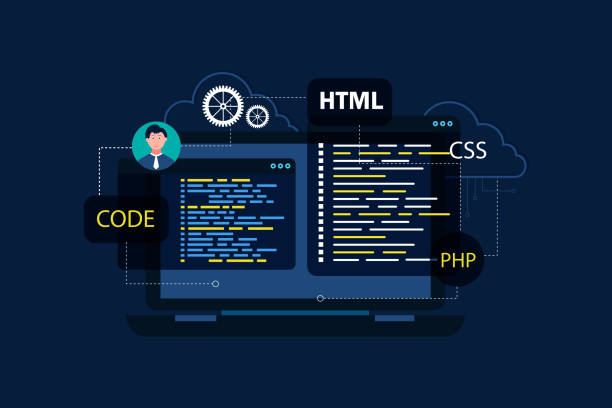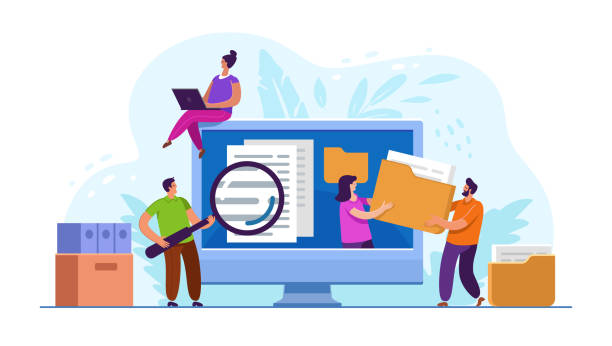An Introduction to Secure Website Design and Its Importance

In today’s fast-paced and ever-changing world, where our reliance on the online space is growing daily, the topic of #Secure_Website_Design and the preservation of information security has become a fundamental concern and necessity.
Website security can no longer be considered a luxury option or a secondary task; rather, it is a vital and inseparable component of any successful #Web_Development project.
An insecure website, regardless of its size and scope, can be exposed to extensive threats that lead to destructive and irreversible consequences.
From the loss of #User_Trust and damage to #Brand_Credibility, to direct financial losses resulting from data breaches and theft of sensitive information, all are among the risks that threaten businesses and even individuals.
Therefore, a secure website design not only means preventing cyber attacks but also means creating a reliable user experience and protecting valuable information of users and organizations.
This domain goes beyond installing a few security plugins or a simple SSL certificate; it requires a comprehensive and layered approach that encompasses all aspects of website development, deployment, and maintenance.
From initial coding and choosing the right architecture to server configurations and database management, every step must be taken with security principles in mind.
This explanatory and educational section highlights the fundamental importance of security in the modern web ecosystem and sets the stage for more specialized discussions.
This preventive approach in secure website design ultimately leads to risk reduction and increased stability of online presence.
Are you dissatisfied with the low sales of your online store?
Rasaweb is your solution for having a professional and high-selling online store.
✅ Significant increase in sales and revenue
✅ Easy and enjoyable shopping experience for customers
⚡ Get a free consultation from Rasaweb now!
Common Web Security Threats and Countermeasures

To achieve a secure website design, understanding common web security threats and methods to counter them is of particular importance.
Understanding how these attacks work helps developers and website administrators create stronger and more effective defenses.
One of the most common and dangerous attacks is SQL Injection, where an attacker injects malicious SQL code through website inputs to access or modify sensitive information.
Countering it requires the use of parameterized statements and strict input validation.
Another attack is Cross-Site Scripting (XSS), where malicious JavaScript code is executed in the victim’s browser and can lead to cookie or session theft.
Filtering and encoding user-generated outputs are ways to prevent XSS.
DDoS (Distributed Denial of Service) attacks also cause service disruption by flooding the server with numerous requests, which requires network-level protection and CDN solutions.
Problems with incomplete authentication and misconfigurations also pave the way for many vulnerabilities.
Using strong authentication, proper session management, and regular review of configurations are essential to strengthen the foundations of secure website design.
This specialized and guidance section, by explicitly stating the challenges, helps increase awareness in countering threats and emphasizes that only a comprehensive secure website design can withstand these threats.
The Role of SSL/TLS Security Protocols in Secure Website Design

One of the main pillars in modern secure website design is the use of SSL/TLS security protocols, which enable websites to migrate from HTTP to HTTPS.
HTTPS is the secure version of HTTP that encrypts communication between the user’s browser and the website server.
This encryption provides three main functions: confidentiality (preventing eavesdropping on information), integrity (ensuring data is not tampered with during transmission), and authentication (verifying the website’s identity to prevent phishing attacks).
To enable HTTPS, a valid SSL/TLS certificate issued by a Certificate Authority (CA) is required.
There are different types of these certificates, including Domain Validation (DV) which only verifies domain ownership and is suitable for personal websites or blogs, and Extended Validation (EV) which offers the highest level of trust and includes a thorough verification of the issuing organization’s identity, often used for banking and e-commerce websites.
Not having an SSL/TLS certificate not only compromises user security but is also detrimental to SEO, as search engines like Google rank HTTPS websites higher.
This explanatory and specialized section demonstrates how a secure website design would be incomplete without HTTPS.
Table 1: Comparison of HTTP and HTTPS
| Feature | HTTP | HTTPS |
|---|---|---|
| Encryption | None | Yes (using SSL/TLS) |
| Default Port | 80 | 443 |
| Reliability (Trust) | Low | High (Green lock display in browser) |
| SEO (Search Engine Ranking) | Negative Score | Positive Score |
| Server CPU Usage | Less | Slightly More (due to encryption) |
The Importance of Continuous Updates and Security Patch Management

Even the best secure website design can easily become vulnerable if not regularly updated and maintained.
Continuous software updates and effective security patch management are the backbone of maintaining a website’s security over time.
Cyber attackers are constantly searching for new vulnerabilities in popular software such as Content Management Systems (CMS) like WordPress, Joomla, Drupal, web servers (Apache, Nginx), databases (MySQL, PostgreSQL), and even programming frameworks.
When a new vulnerability is discovered, software developers quickly release security patches to close these loopholes.
Failure to install these patches promptly makes your website vulnerable to Zero-Day Exploits as well as attacks that exploit publicly disclosed vulnerabilities.
A guidance and specialized approach to secure website design includes developing a systematic plan for regularly checking and applying updates.
This plan should include necessary tests after each update to ensure no interference with website functionality.
This not only helps prevent security breaches but also improves website performance and stability.
Proper patch management requires constant vigilance and commitment and is an integral part of website maintenance.
Are your online sales not meeting your expectations? With Rasaweb, solve the problem of low sales and poor user experience forever!
✅ Increase conversion rate from visitor to customer
✅ Create an enjoyable user experience and boost customer trust
⚡ Act now for a free consultation!
Access Management and Strong Authentication in Secure Website Design

One of the main entry points for cyber attacks is weakness in access management and authentication.
Therefore, implementing strong mechanisms for these two elements is considered a vital principle in secure website design.
Strong authentication means going beyond simple passwords.
Using complex passwords (including a combination of uppercase and lowercase letters, numbers, and symbols) and enforcing their periodic change is the first step.
But more importantly, implementing Multi-Factor Authentication (MFA) adds an additional security layer by requiring at least two factors of identity verification (such as a password and a one-time code via mobile).
This educational and guidance section addresses the importance of these mechanisms.
Alongside authentication, access management is also crucial.
This includes implementing the Principle of Least Privilege, meaning that each user or system should only have access to the minimum resources and permissions necessary to perform its task.
Implementing Role-Based Access Control (RBAC) helps organize and manage permissions precisely.
For example, an editor should not have system administrator access.
A secure website design that adheres to these principles significantly reduces the attack surface and makes it harder for attackers to penetrate.
It is questionable why some organizations still neglect these basic measures, while many security breaches stem from weaknesses in these very issues.
Regular Backups and Data Recovery Strategies

Even with the strongest secure website design mechanisms, the probability of an incident is not zero.
Natural disasters, human error, hardware failure, and successful cyber attacks can all lead to data loss.
In such circumstances, regular backups and having an effective data recovery strategy will be your last line of defense and savior.
Backups should include all website files, databases, and any important server configurations.
There are different types of backup strategies: Full Backup which includes all data; Incremental Backup which only saves changes since the last backup (full or incremental); and Differential Backup which saves changes since the last full backup.
The choice of the best strategy depends on the volume of data, frequency of changes, and the organization’s tolerance for data loss.
More important than taking backups is regular testing of the recovery process.
A backup that cannot be restored is worthless.
Backups should be stored securely and preferably in separate locations (Off-site or Cloud Storage) to be accessible in case the primary server is lost.
This guidance and specialized section emphasizes that backup is a vital part of a resilient secure website design.
An analytical approach to this issue shows that many organizations only realize the importance of this after a disaster, whereas prevention is always cheaper and easier than cure.
Firewalls and Intrusion Detection Systems (IDS/IPS)

At the network and server layers, firewalls, Intrusion Detection Systems (IDS), and Intrusion Prevention Systems (IPS) play a crucial role in protecting a website’s infrastructure and completing a secure website design.
A firewall is a security barrier between the internal network and external networks (such as the Internet) that controls incoming and outgoing traffic based on a set of rules.
Firewalls can block unwanted traffic and restrict access to specific ports.
Intrusion Detection Systems (IDS) operate passively; they monitor network traffic and issue alerts if suspicious activities or known attack patterns are identified.
IDS alone do not stop attacks, they only provide notification.
In contrast, Intrusion Prevention Systems (IPS) operate actively; they not only identify malicious activities but also automatically block suspicious traffic or cut off the attacker’s connection.
Both IDS and IPS can be network-based, monitoring overall network traffic, or host-based, installed on a specific server or device and monitoring its activities.
The combined use of firewalls, IDS, and IPS creates a powerful defensive layer that greatly contributes to secure website design.
This specialized and explanatory section delves into network-level defensive solutions.
Table 2: Differences Between IDS and IPS
| Feature | IDS (Intrusion Detection System) | IPS (Intrusion Prevention System) |
|---|---|---|
| Function | Monitoring and Alerting | Monitoring, Alerting, and Active Blocking |
| Network Position | Out of Traffic Path (Passive) | In Traffic Path (Inline/Active) |
| Reaction to Threat | Only Notifies Administrator | Blocking, Traffic Dropping, Connection Termination |
| Impact on Network Performance | Low (Listener Only) | Higher (Traffic Inspection and Processing) |
| Application Example | Receiving Alerts for Abnormal Traffic | Automatically Blocking DDoS Attacks |
Penetration Testing and Vulnerability Assessment

A secure website design is not achieved solely by implementing defensive mechanisms, but also requires a proactive approach to identifying and addressing weaknesses.
Penetration Testing and Vulnerability Assessment are two key tools in this regard that help organizations assess the security of their systems from an attacker’s perspective.
Penetration Testing is a simulated and controlled attack on your systems that is performed by Ethical Hackers.
The goal is to identify and exploit vulnerabilities that real attackers might exploit.
These tests can include website testing, networks, and even social engineering.
The results of these tests help organizations fix weaknesses before they are discovered by attackers.
Vulnerability Assessment is the process of identifying and classifying security weaknesses in a system, network, or application.
This process typically uses automated vulnerability scanning tools and provides a comprehensive list of known vulnerabilities, but it does not involve exploiting them.
In reality, vulnerability assessment shows “what is wrong,” while penetration testing determines “how far they can penetrate.”
This analytical and guidance section emphasizes the importance of these two processes in the secure website design lifecycle, and shows that security is a continuous process, not a destination.
Are you concerned that your company’s old website is driving away new customers? Rasaweb solves this problem with modern and efficient corporate website design.
✅ Increases your brand credibility.
✅ Helps in targeted customer acquisition.
⚡ Contact Rasaweb now for a free consultation!
Human Challenges and Staff Training in Web Security

Regardless of how much you invest in secure website design and implementing advanced technical solutions, the human element often remains the weakest link in the security chain.
Cyber attackers are well aware of this and that is why attacks like social engineering have become increasingly common.
Attacks such as phishing, spear phishing, and pretexting, focus on deceiving humans into revealing sensitive information or performing unwanted actions.
Many major security breaches have started because an employee clicked on a suspicious link, downloaded an infected file, or disclosed a password in a phishing email.
This shows that staff training and awareness in cybersecurity is as important as implementing firewalls and intrusion detection systems.
Training programs should include identifying phishing emails, the importance of strong passwords and multi-factor authentication, the dangers of public Wi-Fi networks, and how to report suspicious activities.
This educational and entertaining section (with real stories of common deceptions) reminds organizations that security is a shared responsibility.
A secure website design without considering human aspects, can never be completely secure.
The questionable content in this section is why, despite all this awareness, many people still fall victim to simple social engineering attacks.
The answer is that hackers’ skills in deceiving humans have also evolved parallel to technological advancements.
The Future of Secure Website Design and Emerging Trends

The world of cybersecurity is constantly evolving, and the future of secure website design will also be influenced by emerging technological trends and new threats.
One of the most important of these trends is the increasing role of Artificial Intelligence (AI) and Machine Learning.
AI can be very effective in identifying suspicious traffic patterns, predicting attacks, and automating responses to threats.
On the other hand, attackers will also use AI to develop more sophisticated and intelligent attacks, which creates a new challenge for secure website design specialists.
Blockchain technology also has high potential for increasing website security, especially in the areas of authentication and sensitive data management.
The distributed and immutable nature of blockchain can help create stronger authentication systems and more secure databases.
The Zero Trust (no trust) security model is also gaining widespread adoption.
This model assumes that no user or device, whether inside or outside the network, can be trusted unless its identity and authorization are continuously verified.
This approach makes the protection of information and access much more stringent.
This informative and analytical section shows that to maintain a secure website design in the future, organizations must constantly learn and adapt to these changes.
New challenges also demand new solutions, and only a proactive approach can keep you safe from potential attacks.
Investing in research and development and utilizing new technologies is the key to survival in the competitive field of cybersecurity.
Frequently Asked Questions
| Row | Question | Answer |
|---|---|---|
| 1 | What is secure website design? | Secure website design is a process in which websites are built with security measures in mind from the initial stages of development to be protected against cyber attacks, unauthorized access, and data loss. |
| 2 | Why is secure website design important? | Website security is crucial for maintaining user trust, protecting sensitive information (personal and financial), preventing damage to brand reputation, and complying with privacy and security regulations (such as GDPR). Security breaches can lead to financial and legal damages. |
| 3 | What are the most common cyber attacks a website faces? | Some of the most common attacks include SQL Injection, Cross-Site Scripting (XSS), Distributed Denial of Service (DDoS), Brute Force, and credential-based attacks (Credential Stuffing). |
| 4 | What is SQL Injection and how can it be prevented? | SQL Injection is a type of attack where an attacker attempts to manipulate the database or extract information by injecting malicious SQL code into site inputs. To prevent it, one should use Prepared Statements/Parameterized Queries, ORM (Object-Relational Mapping), and strict input validation. |
| 5 | What is Cross-Site Scripting (XSS)? | XSS is a type of attack where an attacker injects malicious scripts (usually JavaScript) into web pages that are executed by other users’ browsers. This can lead to the theft of cookies, session information, or alteration of the website’s appearance. |
| 6 | How can Brute Force attacks on login pages be prevented? | To prevent Brute Force attacks, CAPTCHA, limiting the number of failed login attempts (Account Lockout), Two-Factor Authentication (2FA), and using complex and long passwords should be employed. |
| 7 | What is the role of HTTPS in website security? | HTTPS, using SSL/TLS, encrypts communication between the user’s browser and the website server. This prevents eavesdropping, tampering, or forgery of information during transmission and increases user trust. |
| 8 | What is the importance of Input Validation in security? | Input validation is the process of checking and sanitizing data entered by the user. This prevents injection of malicious code, XSS attacks, SQL Injection, and other vulnerabilities, ensuring that data conforms to the expected format. |
| 9 | Why are regular updates of website systems and software necessary? | Regular updates of the operating system, CMS (like WordPress), plugins, themes, and libraries used resolve known security vulnerabilities. Hackers often exploit weaknesses in outdated software for penetration. |
| 10 | What role do regular backups play in secure website design? | Regular and tested backups of website information (database and files) are a vital layer of defense against data loss due to cyber attacks, human errors, or hardware failure. This enables quick website recovery in case of a disaster. |
And other services of Rasaweb Advertising Agency in the field of advertising
Smart Direct Marketing: Professional optimization to increase sales using custom programming.
Smart Social Media: Revolutionize SEO ranking improvement with the help of attractive UI design.
Smart Marketplace: A specialized service for increasing website traffic growth based on intelligent data analysis.
Smart Digital Branding: A combination of creativity and technology for online growth through attractive UI design.
Smart Data Analysis: Designed for businesses seeking to analyze customer behavior through Google Ads management.
And over a hundred other services in internet advertising, advertising consultation, and organizational solutions
Internet Advertising | Advertising Strategy | Advertorials
References
Principles of Secure Website Design and Key Tips
The Importance of Using SSL Certificates in Web Security
Comprehensive Website Security Guide for Developers
How to Protect Your Website Against Cyber Attacks?
? Are you ready to transform your business in the digital world? With Rasaweb Afarin Digital Marketing Agency, from SEO strategies to professional WordPress website design, achieve the best results and build a bright future for your brand.
📍 Tehran, Mirdamad Street, next to Bank Markazi, Southern Kazeroon Alley, Ramin Alley, No. 6




